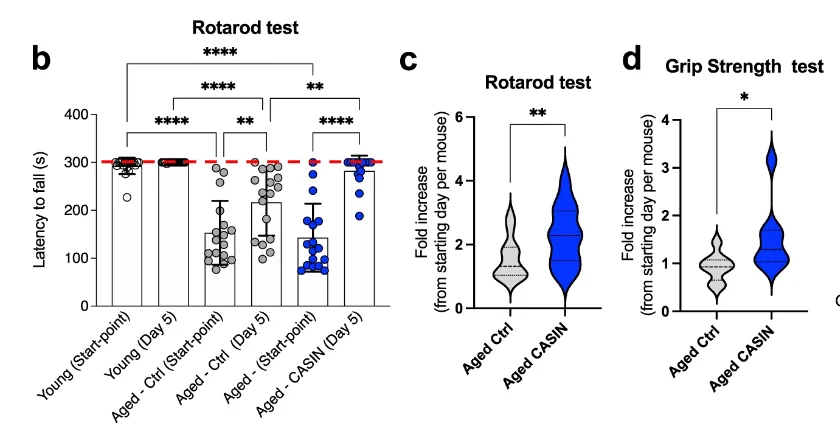Researchers publishing in the Nature journal npj Regenerative Medicine have zeroed in on a major reason behind stem cell exhaustion and determined that inhibiting it has significantly rejuvenative effects.
A protein that suppresses stem cells
In both humans and mice, the protein Cdc42 increases with aging. This is because its natural inhibitor, Cdc42GAP, decreases in expression. Mice with Cdc42GAP genetically knocked out experience substantially faster aging than wild-type mice [1], and an increase in Cdc42 is associated with aging in human beings [2].
These researchers have previously reported that inhibiting Cdc42 in aged mice for only four days increased their lifespan [3]. This new research aimed to discover more of the effects of Cdc42 and to determine if they are due to its effects on stem cells.
Inhibiting Cdc42 improves fitness in older mice
For their first experiment, the researchers injected aged mice with the Cdc42 inhibitor CASIN and compared them to young mice and an aged control group. The results were striking. In a rotarod test, almost none of the aged mice could stay on for the full five minutes like the young mice could; after five days of CASIN, almost all of them could. This performance was significantly better than the control group.

In cellular studies, Cdc42 was also shown to spur aging phenotypes in skeletal muscle taken from young mice, while CASIN treatment was shown to youthen the phenotypes of the same tissue taken from older mice. The researchers found that tissue taken from CASIN-treated older mice also benefited, with significantly increased myofiber cross-sectional area compared to untreated older mice.
Encouraged by these results, the researchers then challenged aged CASIN-treated mice, along with a control group, with the muscle-damaging drug Notexin. In the CASIN-treated mice, muscle stem cells restored the damaged tissue to a significantly greater degree than in the untreated mice.
Restoration of blood-making cells
Beneficial results were shown in the bone marrow. CASIN did not seem to affect the absolute number of the resident hematopoietic stem cells (HSCs), which are responsible for forming components of blood. However, the relative placement and polarity of HSCs changes with age, and CASIN treatment was shown to restore these metrics to their youthful values. Gene expression was also shown to be more youthful.
These cells were also shown to be more effective in basic function. Normally, aged stem cells do not perform as efficiently as their younger counterparts and differentiate into fewer critical immune cells. This limits the effectiveness of plasma-based rejuvenation treatments [4].
However, in lethally irradiated mice, stem cells taken from CASIN-treated mice behaved significantly more like their younger counterparts in multiple critical ways, including engraftment and B cell differentiation. These effects were not perfect, nor were they statistically significant in every tested metric.
Conclusion
Cdc42 is clearly an important component of stem cell exhaustion, one of the hallmarks of aging, and its increase with aging has visibly deleterious effects. Interventions that reduce Cdc42 might be useful in the treatment of sarcopenia and other aspects of muscle and blood aging, particularly if other stem cell-depleting factors are targeted at the same time. As always, human clinical trials will be necessary to determine if this is truly the case.
Literature
[1] Wang, L., Yang, L., Debidda, M., Witte, D., & Zheng, Y. (2007). Cdc42 GTPase-activating protein deficiency promotes genomic instability and premature aging-like phenotypes. Proceedings of the National Academy of Sciences, 104(4), 1248-1253.
[2] Amoah, A., Keller, A., Emini, R., Hoenicka, M., Liebold, A., Vollmer, A., … & Geiger, H. (2022). Aging of human hematopoietic stem cells is linked to changes in Cdc42 activity. haematologica, 107(2), 393.
[3] Florian, M. C., Leins, H., Gobs, M., Han, Y., Marka, G., Soller, K., … & Geiger, H. (2020). Inhibition of Cdc42 activity extends lifespan and decreases circulating inflammatory cytokines in aged female C57BL/6 mice. Aging cell, 19(9), e13208.
[4] Ho, T. T., Dellorusso, P. V., Verovskaya, E. V., Bakker, S. T., Flach, J., Smith, L. K., … & Passegué, E. (2021). Aged hematopoietic stem cells are refractory to bloodborne systemic rejuvenation interventions. Journal of Experimental Medicine, 218(7), e20210223.




